NASA APOD #1069-1077
#1069 7,000 Stars And The Milky Way May 23, 1998
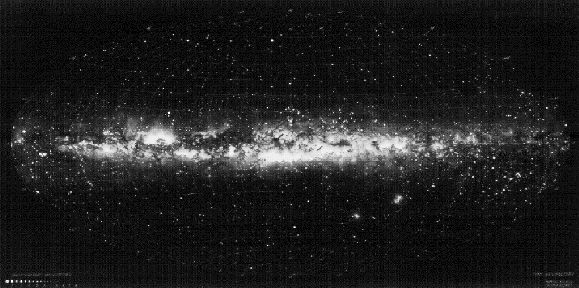
“This panorama view of the sky is really a drawing. It was made in the 1950s under the supervision of astronomer Knut Lundmark at the Lund Observatory in Sweden. To create the picture, draftsmen used a mathematical distortion to map the entire sky onto an oval shaped image with the plane of our Milky Way Galaxy along the center and the north galactic pole at the top. 7,000 individual stars are shown as white dots, size indicating brightness. The "Milky Way" clouds, actually the combined light of dim, unresolved stars in the densely populated galactic plane, are accurately painted on, interrupted by dramatic dark dust lanes. The overall effect is photographic in quality and represents the visible sky. Can you identify any familiar landmarks or constellations? For starters, Orion is at the right edge of the picture, just below the galactic plane and the Large and Small Magellanic Clouds are visible as fuzzy patches in the lower right quadrant."
Copyright: Public domain
#1070 A High Energy Fleet May 24, 1998
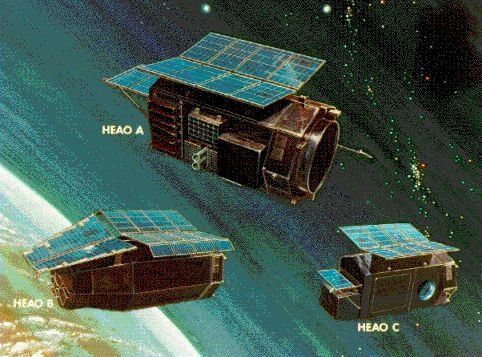
“Looking like a fleet of futuristic starcruisers, NASA's highly successful series of High Energy Astrophysical Observatory (HEAO) spacecraft appear poised over planet Earth. Labeled A, B, and C in this vintage illustration, the spacebased telescopes were known as HEAO-1, HEAO-2, and HEAO-3 respectively. HEAO-1 and HEAO-2 were responsible for revealing to earthlings the wonders of the x-ray sky, discovering 1,000s of celestial sources of high-energy radiation. HEAO-2, also known as the Einstein Observatory, was launched near the date of the famous physicist's 100th birthday (November, 1978) and was the first large, fully imaging x-ray telescope in space. HEAO-3, the last in the series, was launched in 1979 and measured high energy cosmic-ray particles and gamma-rays. These satellite observatories were roughly 18 feet long and weighed about 7,000 pounds. Their missions completed, all have fallen from orbit and burned up harmessly in the atmosphere."
Copyright: Public domain
#1071 M83: A Barred Spiral Galaxy May 25, 1998
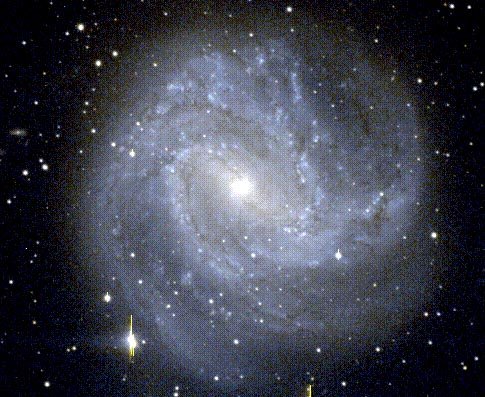
“M83 is a bright spiral galaxy that can be found with a small telescope in the constellation of Hydra. M83 is a member of the Centaurus group of galaxies, a nearby group dominated by the massive galaxy Centaurus A. It takes light about 15 million years to reach us from M83. The spiral arms are given a blue color by the many bright young stars that have recently formed there. Dark dust lanes are also visible. Stars and gas in spiral arms seem to be responding to much more mass than is visible here, implying that galaxies are predominantly composed of some sort of dark matter. Finding the nature of this dark matter remains one of the great challenges of modern science."
Copyright: Public domain
#1072 A Seemingly Square Sun May 26, 1998

“Isn't the Sun round? Yes, but in the above picture, the Earth's atmosphere makes it appear almost square. Here a layer of air near the Earth was so warm it acted like a giant lens, creating increasingly distorted paths for sunlight to reach the camera. Similarly, on a long flat highway, it may appear that the road in the distance is covered with water. In this case, light from the blue sky is being unusually refracted by warm air just above the dry road. No matter how the Earth's atmosphere makes the Sun appear, the Sun will always be spherical. This setting Sun was photographed over Lake Michigan in Muskegon, MI."
Copyright: T. Polakis
#1073 Magnetar May 27, 1998
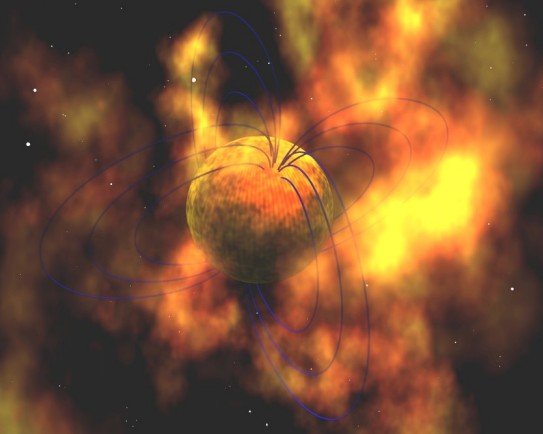
“What do you call a neutron star with a super-strong magnetic field? You guessed it ... a Magnetar. Imagine a star with more mass than the sun, the density of a neutron, and a magnetic field about a thousand trillion (a one followed by 15 zeroes) times stronger than Earth's. It sounds exotic and theoretical, but strong evidence for the existence of magnetars has recently been announced based on data from orbiting X-ray and Gamma-ray observatories. Neutron stars are formed in the violent crucibles of stellar explosions. Some become pulsars with relatively weak magnetic fields, spinning and emitting pulses of electromagnetic radiation as their rotation slows. However, astronomers now believe that some become magnetars, with magnetic fields so intense that the solid neutron star crust buckles and shifts under its influence. The resulting star quakes could repeatedly generate brief flashes of hard X-rays and soft gamma-rays giving rise to the rare but mysterious "soft gamma repeaters" (not to be confused with " gamma-ray bursters"!). This still frame from an animation illustrating a spinning, flashing magnetar emphasizes the looping magnetic field lines embedded in the X-ray hot neutron star surface."
Copyright: Public domain
#1074 Afterglow May 28, 1998

“This sequence of three false color X-ray pictures from the Italian/Dutch BeppoSAX satellite follows the fading glow from a gamma-ray burster. This burster triggered orbiting gamma-ray observatories on December 14, 1997 and within 6.5 hours the sensitive X-ray cameras onboard BeppoSAX had been turned to record the first image (left) of the afterglow. Each image covers a field about the size of the full moon with the position of the afterglow indicated by the white circle. The first two pictures were taken 6 hours apart, while the final picture was made 2 days after the gamma-ray burst. Initiated by an unknown but immensely powerful explosive event, gamma-ray bursts are thought to be caused by blast waves of particles moving at nearly the speed of light. The expanding cosmic fireball produces seconds-long bursts of gamma-rays and then as it slows and sweeps up surrounding material, generates an afterglow visible for many days at X-ray, optical, and radio energies. Evidence indicates that this burst originated at a distance of 12 billion light-years requiring a fantastic and extreme energy source. What could power a gamma-ray burst?"
Copyright: Public domain
#1075 An Extrasolar Planet? May 29, 1998
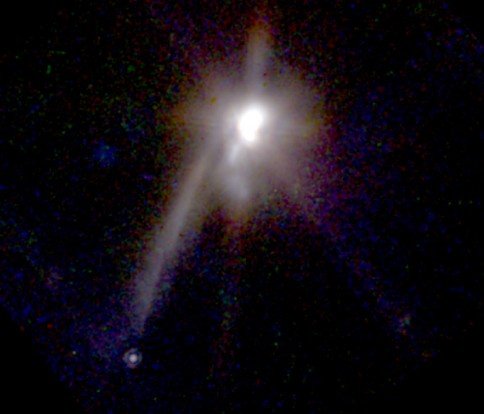
“This infrared Hubble Space Telescope view may contain the first ever direct image of a planet outside our own solar system. The picture shows a very young double star located about 450 light-years away toward the constellation of Taurus. Cataloged as TMR-1 (Taurus Molecular Ring star 1), the binary system is still embedded in the dust cloud that formed it. This double star and dust cloud are the brightest grouping in the picture, glowing strongly at infrared wavelengths. A filament extends from the binary system toward the lower left and points toward the spot of light representing the candidate planet. Astronomers believe this planet is a "runaway" object which was gravitationally ejected, the filament tracing the path to its present location at about 1500 times the Earth-Sun distance from the parent star system. Models suggest that the planet and binary system are a mere 300,000 years old, with the planet having a mass of about 2 to 3 Jupiters. Future observations to look for the planet's continued runaway motion and spectral signatures should be able to confirm the nature of this object. While this and other tantalizing discoveries of extrasolar planetary objects and protoplanetary disks don't seem to offer direct examples of solar systems like our own, they do strongly hint that planet formation is a varied and common process. Update: TMR-1 likely just a background star."
Copyright: Public domain
#1076 Water World May 30, 1998
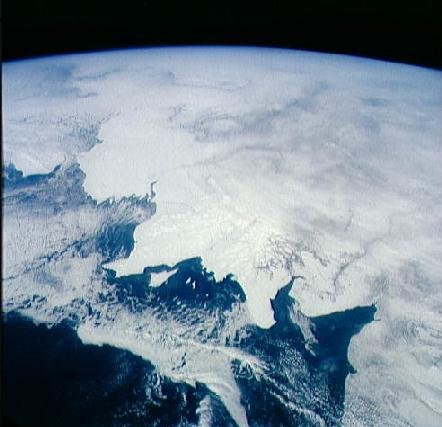
“Water (Dihydrogen Oxide, H2O) is a truly remarkable chemical compound, fundamental to life on Earth. Earth is the only planet in the Solar System where the present surface temperature and pressure allow the three forms of water, solid (ice), liquid (ocean), and gas (water vapor condensing in clouds) to exist simultaneously. Water in one of these forms accounts for everything visible in this view of Earth from space looking north at the Bering Sea and the coast of Alaska, USA, around Bristol Bay."
Copyright: Public domain
#1077 Phobos: Doomed Moon of Mars May 31, 1998
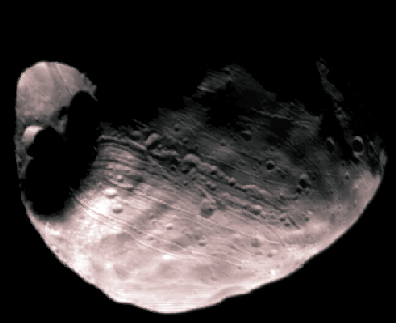
“Phobos is doomed. Mars, the red planet named for the Roman god of war, has two tiny moons, Phobos and Deimos, whose names are derived from the Greek for Fear and Panic. These Martian moons may well be captured asteroids originating in the asteroid belt between Mars and Jupiter or perhaps from even more distant reaches of the Solar System. In this 1977 Viking orbiter image, the largest moon, Phobos, is seen to be a heavily cratered asteroid-like object. It is about 17 miles across and zips through the Martian sky completing an orbit in less than 8 hours. Phobos orbits so close to Mars, (about 3,600 miles above the surface compared to 250,000 miles for our Moon) that gravitational tidal forces are dragging it down. In 100 million years or so it should crash into the surface or be shattered by stress caused by the relentless tidal forces, the debris forming a ring around Mars."
Copyright: Public domain
Upvote! Resteem! Comment! As you like it! Thank you for attention!